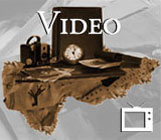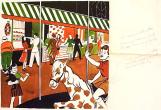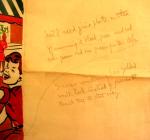1
Making Printing HistoryAn innovation now recorded in the history of printing in Canada, along with other advancements, all combining to picture the scope and progress of the industry, was the first engraving in this country of wood blocks from which multi-colored pictorial posters were printed.
This was done by Enterprise Show Print at Rouleau, and it was the only printing plant in Canada ever to do this type of work.
... (B)ut none attempted the intricate and demanding technique required of the wood engraver in cutting blocks for pictorial posters.
For almost half a century, show printing establishments in the United States, where poster printing was highly specialized, turned out that type of poster.
The use of wood blocks results in the reduction of production costs, particularly for pictorial posters.
Wood engraving in the Enterprise Show Print plant was begun in 1914. The skill of hand carving such things as perfectly straight lines and true circles, had to be acquired as well as an intimate knowledge of the entire procedure from original drawings to completed posters ready to be lifted from the delivery table of the printing press. (Excerpt from Paper, Pen and Ink by Andrew King, Pg 79)
3
It was a great time and I will never forget the day. I was at the press and someone came in the office.I went up and this very distinguished looking man said to me, "I want to know everything there is to know about show printing," and he stopped and looked down at me - he was a good sized man- "and obviously you are not the King that I want to talk to."
He was a professor with Massey College in Toronto.
I said, "You need to talk to my grandpa."
He and grandpa spent three days together. He did give the professor a set of blocks and
you would think he gave the man a million dollars. It was just a prized possession, he was so gratified over it
Our plant was just a block from the train station. I rememebr going to the train station with him and I remember standing at the train and he ordered up a sleeperberth and he put the wood blocks in the sleeper berth and he told the man, "Is this the same car that will transfer in Winnipeg?"
"No, you have to get another train in Winnipeg."
"Don't you come in my car, don't you make my bed, don't do a thing. These wooden blocks do not get touched by human hands."
They made their way back to Toronto and when I was in Toronto, we went to the college, and it was under construction at the time, but we saw the blocks and there is an official King's Corner at the university.
Doug King
4
Big Show Large Girl Drawing on Onion Skin King Show Prints and Enterprise Show Prints1 January 1920

5
At first we did not even know the proper size of the hand chisels required for cutting V- and U-shaped grooves which outlines the picture details, after which the larger blank areas were routed out by a power machine. Then, it had to be learned that a V-tool was more suited for carving a certain style of picture than a U-tool; there were other styles that would call for a U-tool. ...Experimentation and experience eventually conquered the technique of hand wood engraving. (Excerpt from Paper, Pen and Ink by Andrew King, Pg 80)
6
We had to learn how best to transfer the drawing to the boards in readiness for carving and separating its colors. Practically all posters were printed in three colors - yellow, red and blue.A board had to be carved for each color, each carrying only the portions of the picture calling for one of the three specific colors.
A clever artist would be able to draw five-color pictures requiring the use of only three colors of ink. This was accomplished by overprinting, using semi-transparent inks, so that yellow over blue would produce a shade of green, or yellow over red produce orange. This procedure, however, required the printing of the different colors out of normal sequence, so that the artist had to be very careful how he used the colors on his drawing. It also required acquisition of much technical knowledge of printing inks.
Getting suitable drawings at first was a real problem. Not every commercial artist had the technique required to draw good poster pictures which called for skill in using masses of color, rather than fine line or intermediate color tints. (Excerpt from Paper, Pen and Ink by Andrew King, Pg 80)
8
This is a rendering of an artwork that someone did for a poster. Then they would take this and put it on an onion skin type paper.Put an oil on the paper. Then take the paper, turn it upside down, put it onto the block and trace the particular color they were doing on that block.
Bob King
10
Facial expressions and other effects have to be produced by proper shaping and placing of color masses and heavy lines. The skilled poster artist can produce varied expressions of an eye by manipulating three lines and a round spot in various shapings and relative positioning to each other. This type of drawing is simplicity in itself - yet so difficult because of its simplicity.But in catering to the amusement and entertainment field the choice off available art is further narrowed down. That which is "away out" is taboo.
... An artist is needed who can picture wild animals, clowns, ferris wheels, horses, acrobats, and other features common to carnivals and circuses, at the peak of their exciting performances.
At first we had to buy our drawings from artists in Seattle, Washington, which was most inconvenient, especially when someone wanted a pictorial poster in a hurry. (Excerpt from Paper, Pen and Ink by Andrew King, Pg 81)



